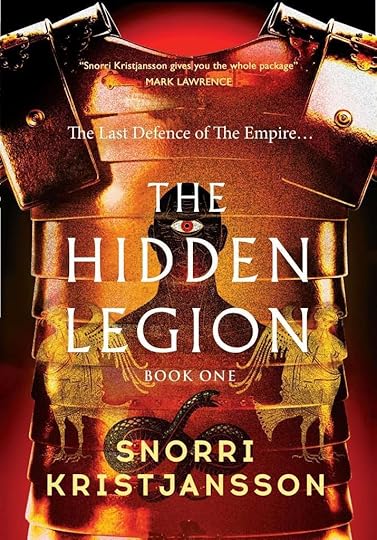Adrian Collins's Blog, page 90
July 9, 2023
REVIEW: Secret Invasion (2023)
Secret Invasion was a show I was really looking forward to. I’m a huge fan of the Marvel Cinematic Universe but, unfortunately (for Disney), it’s been running out of steam ever since Avengers: Endgame. The X-men, Fantastic Four, Blade, and other properties coming back offer it opportunities to breathe new life into the franchise but it’s kind of meandering right now with so many films killing off or retiring characters. No, I’m not bitter about Doctor Strange and the Multiverse of Madness.
Disney+ has also pushed a heavy focus on its television shows when they probably should have made at least a few of these movies. Hawkeye, The Falcon and the Winter Soldier, and even Moon Knight feel like they could have been trimmed a bit before being made into movies. Some, like She-Hulk, Ms. Marvel, and Loki are better paced for being television series.
So, what did I think of Secret Invasion’s pilot? Well, my impression is mixed. Secret Invasion was a somewhat mediocre follow-up to Avengers Disassembled, The House of M, X-men: Decimation, and Civil War. Basically, the Skrulls show up, have been replacing heroes and then they attack everyone with their superpowers. It also played into some uncomfortable politics with the advertising showing the Skrulls invoking Obama’s campaign speeches as well as the Skrulls being based on ISIS.
The television version is even more confusing in its politics with the Skrulls in the Marvel Cinematic Universe being different from the comic. The Skrulls in the comic universe are an authoritarian racist empire that loses their homeworld before deciding to take Earth as their new one. The Skrulls in the Marvel Cinematic Universe are a bunch of homeless refugees being hunted by Space Nazis AKA the Kree.
The show is left with the uncomfortable Far Right talking point that refugees are just a bunch of potential terrorists waiting to eventually overthrow their host nation. Doctor Who’s “The Zygon Invasion” managed to thread the needle with the distinctly similar ‘refugees on Earth with shapeshifting alien’ plot with a focus on the people involved being victims as much as they are aggressors.
Secret Invasion has the premise that the Skrulls, living among us for thirty years, now want to kill all of humanity and take over the Earth for…reasons. Nick Fury (Sam Jackson) comes back from his space station to try to deal with the problem. Aiding Nick Fury in this is Talos (Ben Mendelsohn) and Maria HIll (Colbie Smulders). Talos’ daughter, G’iah (Emilia Clark), is part of the radicalized Skrulls but still has a conscience. The main Skrull, Gravik, is planning to kill all of humanity by getting America to go to war with Russia.
Honestly, things aren’t well-defined and I’m not sure why the Skrulls have decided to become genocidal now. There doesn’t seem to be a specific inciting event. It seems like they skipped a few steps. It doesn’t seem like there’s so many Skrulls that they need an entire planet to take over. So, it’s a big jump to genocide and seemingly having all of the Skrulls but for a handful want to kill every human makes it seem like the show is saying refugees are untrustworthy monsters.
Then there’s the fact a major character of the MCU, or at least a well-liked well-beloved one, is killed for seemingly no other reason than to ramp up the stakes. As a fan of the character, I was not a fan of this development and feel like the show does not benefit from it in the slightest. Indeed, it almost caused me to drop it completely.
Right now, I’m not feeling Secret Invasion. The show seems to be rushing into its storyline, does not seem to have done much to set up the Skrulls as villains, and hasn’t introduced its bad guy or his motivations well. Plus, killing the character it did was a big mistake for those who are the sort of MCU superfans that would best enjoy this series.
The post REVIEW: Secret Invasion (2023) appeared first on Grimdark Magazine.
Review: The Dead Take the A Train by Cassandra Khaw and Richard Kadrey
Cassandra Khaw teams up with Sandman Slim author Richard Kadrey for The Dead Take the A Train, their new urban dark fantasy set in a riotous, magic-infused New York City. Khaw and Kadrey are a match made in hell, spawning horrific gods and demons who run amok in the rotten core of the Big Apple.
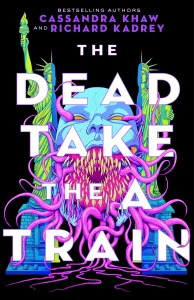 Freelance magic operative, Julie Crews, is a coked-up whirlwind of chaos, whose self-destructive tendencies are matched only by the unbridled mayhem she brings to her commissions. As the novel opens, Julie executes an anarchic job at a bachelorette party featuring a possessed bride-to-be who gives new meaning to the word bridezilla.
Freelance magic operative, Julie Crews, is a coked-up whirlwind of chaos, whose self-destructive tendencies are matched only by the unbridled mayhem she brings to her commissions. As the novel opens, Julie executes an anarchic job at a bachelorette party featuring a possessed bride-to-be who gives new meaning to the word bridezilla.
Despite her proven track record taking on the dirtiest, most dangerous jobs in a demon-infested New York, thirtysomething Julie can’t seem to get ahead in her career or social standing. It doesn’t help that her ex-lover, Tyler, takes credit for their work and is climbing the corporate ladder at a prestigious, deep-pocketed Wall Street-type firm.
Julie decides to summon a guardian angel to help pull her life together and advance her career. But the angel is actually a shapeshifting elder god bent on bringing global annihilation in a New York minute.
The Dead Take the A Train serves as a scathing satire of American capitalism, as Khaw and Kadrey skewer Wall Street culture and its obsession with climbing the corporate ladder. In many ways, The Dead Take the A Train feels like a nightmarish dark fantasy take on The Wolf of Wall Street. But at its core, the novel is also a feminist tale of a strong woman who accepts no nonsense as she blasts herself at the corporate glass ceiling.
The Dead Take the A Train also reminds me a bit of Neverwhere by Neil Gaiman and Hard-Boiled Wonderland and the End of the World by Haruki Murakami, both dark fantasies that feature horrific creatures hidden beneath the surfaces of London and Tokyo, respectively. Compared to these novels, Khaw and Kadrey have moved the action to New York and significantly amped up both the horror and hysterics.
The Dead Take the A Train is a fast-paced madhouse of mayhem combining the best of Kadrey’s thrillers with Khaw’s gruesome Lovecraftian horror. It’s also blisteringly funny, striking the perfect balance between humor and horror. The writing flows smoothly throughout the novel, with Khaw and Kadrey finding a common voice that perfectly suits the irreverent nature of the tale. My only complaint is that the novel feels too long, and the plot could have been tightened up in several places.
Overall, The Dead Take the A Train is a blast and highly recommended for dark fantasy and horror fans looking for a good time. The story will continue with Khaw and Kadrey’s next volume of their Carrion City duology.
4/5
Read The Dead Take the A Train by Cassandra Khaw and Richard KadreyThe post Review: The Dead Take the A Train by Cassandra Khaw and Richard Kadrey appeared first on Grimdark Magazine.
July 7, 2023
REVIEW: The Curse of Saints by Kate Dramis
In The Curse of Saints, the first in a trilogy from debut author Kate Dramis, we are introduced to a kingdom rife with the power of Visya’s; individuals who are blessed with affinities of raw, god-like magic. Visya powers fall under any three categories: Physical Affinities, Elemental Affinities, and Mind, Emotion & Sensation Affinities. Our protagonist, Aya, falls under the last, possessing the power of persuasion. These powers, however, have been bound to never grow strong enough to challenge the Nine Divine, the realm’s gods. In a nearby kingdom, there are rumours of a dark magic arising, threatening to reach Aya’s home. It is this dark magic that sets the plot of the book into motion, where Aya, the Queen’s Spymaster, is forced to investigate this threat alongside her rival Will, the Queen’s Enforcer and Second. It is on this journey that Aya discovers that her affinity is one that spills over the bounds that restrict the Visya, placing her at risk of becoming a weapon in a war she does not know how to win, or might not necessarily want to.
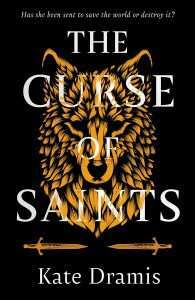 The Curse of Saints is built on the foundations of what could have been a solid fantasy novel – a complex magic system, warring kingdoms, vague prophecies and morally grey characters. So, it is a shame that the novel ultimately fails to deliver. The book becomes overwhelmed with all of the fantastical elements it tries to accomplish, slightly skimming the surface but never exploring deep enough into the elements to have a substantial impact. The world-building, in turn, felt incredibly rushed, and so I felt very little connection to the kingdom or the characters.
The Curse of Saints is built on the foundations of what could have been a solid fantasy novel – a complex magic system, warring kingdoms, vague prophecies and morally grey characters. So, it is a shame that the novel ultimately fails to deliver. The book becomes overwhelmed with all of the fantastical elements it tries to accomplish, slightly skimming the surface but never exploring deep enough into the elements to have a substantial impact. The world-building, in turn, felt incredibly rushed, and so I felt very little connection to the kingdom or the characters.
For instance, we spend some time in the first part of the novel learning that Visya’s have wolf companions that are bonded to them, something that is historically sacred within the religion that rules the realm. We even learn the names of both Aya’s and Will’s bonded wolves, only to never hear of them again. I do hope this is an element that is explored further in the rest of the series as it could definitely result in an intriguing layer to the story, because honestly – who doesn’t love an animal companion?
I did, however, greatly enjoy the political tension that permeates once we reach part two of the novel: Enemies and Allies. In this section, we are introduced to the third point-of-view, Prince Aidon, the heir to the neighbouring kingdom of Trahir. The thread that weaves Aya, Will and Aidon together slowly unravels as the political intrigue arises, whereby each character must question how far they are willing to let their budding friendships last in the greater political game that they have become pawns in.
Ultimately, The Curse of Saints felt overwhelmingly generic. I do, however, feel that the bones of the story have promise. Once it overcomes the awkward characterizations, and we begin to learn more of each individual’s personalities, as well as each kingdom’s politics, I am hopeful that Kate Dramis can steer the story away from the predictability that many recent fantasies find themselves victim to.
The post REVIEW: The Curse of Saints by Kate Dramis appeared first on Grimdark Magazine.
July 6, 2023
REVIEW: The Edge of Sleep by Jake Emmanuel and Willie Block
The Edge of Sleep by Jake Emmanuel and Willie Block was one of the best SF podcasts in recent memory. I remember being utterly riveted when I first listened to it, headphones clamped to my ears while I did the housework and followed Dave, Linda and Matteo through an apocalyptic world of sleepless misery. The story had mystery, tension and old-fashioned civilisation-crumbling drama. High production values, fantastic voice acting, and a propulsive plot all combined together for something memorable.
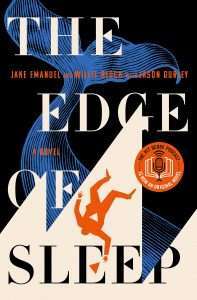 True, the first season ended somewhat unresolved, and a second season is still yet to be forthcoming, but I had high hopes for the novelisation, which has just been released.
True, the first season ended somewhat unresolved, and a second season is still yet to be forthcoming, but I had high hopes for the novelisation, which has just been released.
The Edge of Sleep novelisation also adds Jason Gurley to the writer’s credits. One presumes Gurley was brought on board primarily to assist in translating the original podcast into print, with the core plot already having been established in the aforementioned podcast series. However, it is also worth noting that aspects of the plot differ notably between the mediums, something I’ll discuss in more detail later. Unless specifically mentioned as otherwise, the references to the plot will be references to the novelisation.
The Edge of Sleep begins with Dave and Matteo, a pair of nightwatchmen, working a boring graveyard shift. After Dave literally falls asleep on the job, Matteo convinces him they should shirk off to a party, ostensibly to help lovesick Dave reclaim his mojo but more likely so Matteo can have a good time. Matteo, rowdy and irreverent, is a good foil for Dave, who tends toward melancholy and introspection.
In both the podcast and the novel, Dave is cast as the protagonist, while Matteo is probably the strongest supporting character, adding moments of levity to what would otherwise be an unremittingly sombre tone if Dave were to be the sole point of focus.
After speeding off to the party in Matteo’s Camaro, their night begins dramatically going downhill. First, the party is dead. Second, the guy on the couch is dead. Third, when they get to the hospital with a body in the Camaro’s back seat, everyone there is also dead.
Well, almost everyone. There’s a feisty nurse named Linda and she joins Dave and Matteo as they attempt to figure out just what happened during the night, and what they can do to avoid the same fate. A ticking clock ensues, that ticking clock being their own bodies’ desire for sleep, as they race to solve the mystery.
Dave himself, it seems, might hold part of the solution in his own childhood, during which he was plagued by nightmares of an elephant figure. Even as an adult, these childhood memories have haunted him and occasionally caused him to drop into strange, sleepwalking trances. The only problem is, if the answers are to be found in Dave’s dreams, and people die when they fall asleep, it’s not going to be easy.
So, how does the Edge of Sleep novel stack up? Well, I’ve got mixed feelings about the adaptation.
In both the book and the podcast, Dave is cast as the main protagonist, but the novel loses the benefit of Dave’s first-person monologues, which the podcast interjects throughout the episodes. Partly because of this, the podcast feels more tightly welded to Dave’s point-of-view, whereas the novel paints on a broader canvas. This is an effect heightened by the narrative decision to have certain chapters segue over to other, minor point-of-view characters.
On the downside, this dilutes the urgency and immediacy of the action, something crucial to the suspense of the podcast. Another downside, unfortunately, is that some of the better parts of the podcast were left on the cutting room floor.
I gather this was done to give the novel wider appeal, but it saps some of the brutality, urgency and tension of the original podcast. The most notable example is that the plot aspect of The Trespasser, a serial rapist loose in this deteriorating world, is completely cut. The Trespasser is integral to a good chunk of the podcast and raises the stakes and tension palpably during the middle section. The part where the Trespasser straps Dave down and prepares to castrate him is a good example.
But perhaps the very nature of that example provides an answer to why the decision was made to remove him in his entirety from the plot. Still, if you’re a grimdark reader, I know which version you’ll prefer.
Similarly, the podcast of The Edge of Sleep has a stronger depiction of Dave’s relationship with his ex-girlfriend, Katie, who also joins the group later on. Early in the story, there is a sense that their relationship was marred by violence that occurred during one of Dave’s dream-fugue states. To create tension, the novel and podcast both use this device of a violent incident in their past that Dave can’t remember, but the podcast utilises it much better and seems less afraid to lean on it for this purpose.
My advice is that if you have to choose whether to try The Edge of Sleep novel or the podcast, choose the podcast. It contains a lot more of the graphic and fun bits, whereas the novel is noticeably sanitised. If you enjoyed the podcast, then the novel will certainly scratch that same itch, and for that reason I do recommend it if you’re a fan, but expect less rather than more of the same. Still enjoyable, but not quite sitting at the same lofty heights.
Read The Edge of Sleep by Jake Emmanuel and Willie BlockThe post REVIEW: The Edge of Sleep by Jake Emmanuel and Willie Block appeared first on Grimdark Magazine.
July 5, 2023
REVIEW: Silo (AppleTV)
Silo is the brilliant new, dystopian TV series based on the best-selling sci-fi novels written by Hugh Howey. The silo is a 144-floor indoor city that is meant to hold the last humans alive following some unexplained disaster. It is a perfectly paced dark mystery with major discoveries in every episode.
The prologue of sorts sets everything up in the first episode. We are introduced to Allison Becker (played by the amazing Rashida Jones) and her husband Sheriff Holston Becker as they request permission to have a baby in the tightly controlled silo (think of a grander version of Fallout’s vaults). Through their eyes, we witness the powers at play in the silo and the class system creating tension and tragedy in the difficult structure. Men and women stare out of the increasingly murky window to the outside world in hope and this window is only cleaned by volunteers willing to sacrifice themselves to the fatal conditions in the outside world, or those sent out as punishment. It is a fascinating world and the first episode does some wonderful heavy lifting in introducing the story’s world, themes, and drama. When the story’s true protagonist turns up (Juliette Nichols), the audience is ready to dive right into this and solve the mysteries set up early on. It is a show that doesn’t want to tell you everything straight away and the respect it gives its audience pays off. There are many things we don’t know about the world, like when it takes place in human history, but that just adds to the overall mystery and suspense in the show.
Rebecca Ferguson (Dune, Doctor Sleep) as Juliette carries Silo forward as the new sheriff with a chip on her shoulder and a mystery to solve. She’s not going to let anyone get in her way as she barges through the red tape placed before her and the menacing heavies sent to keep her from solving the many mysteries of the silo. Her story is captivating as she shifts from one role to another and we watch her grow into a job thrust upon her at one of the most difficult times in her life. Silo gradually reveals her tragic backstory that links in with the wider history of the silo and the complicated relationship with her father (Game of Thrones’ Iain Glen using an off-putting accent that I eventually got used to). The cast is a strong one with Rebecca Ferguson on her best form. Recent news of her possibly playing Monza Murcatto in Joe Abercrombie’s Best Served Cold adaptation will mean grimdark fans will be keeping a close eye on her and she does not disappoint here as a bitter woman out for answers and revenge. Silo offers a world where the characters and the audience never really know who to trust and when the twists come, they are earned through the strong writing and superb acting.
Silo is must-see TV. It is a dark sci-fi tale full of gripping mysteries and more cliffhangers than a bouldering competition. The dark world of Silo is a stunning achievement from the production team with the writing and cast strong throughout the ten episodes. In a time when we are spoilt for dark fantasy and sci-fi on TV, go out of your way to watch this! I can’t wait for season 2!
The post REVIEW: Silo (AppleTV) appeared first on Grimdark Magazine.
July 4, 2023
REVIEW: The Pyres of Vengeance by NC Koussis
The Pyres of Vengeance is the second entry in the Swords of Dominion series by N.C. Koussis and the follow-up to his debut novel, The Sword of Mercy and Wrath. The Pyres of Vengeance continues the story of Selene, who is now pregnant and about to give birth, fighting to stay alive in a land full of violent monsters and religious zealotry.
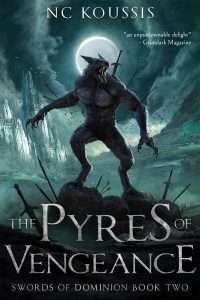 The Pyres of Vengeance represents a seismic shift in tone compared to the first book of the series, especially with the introduction of Richter, a new point-of-view character who is the embodiment of all the most terrible things you can imagine, and probably a bit more. Normally I don’t pay much attention to trigger warnings, but here I suggest that readers take them seriously, as The Pyres of Vengeance includes sexual abuse, rape, pedophilia, infanticide, and plenty of extreme violence.
The Pyres of Vengeance represents a seismic shift in tone compared to the first book of the series, especially with the introduction of Richter, a new point-of-view character who is the embodiment of all the most terrible things you can imagine, and probably a bit more. Normally I don’t pay much attention to trigger warnings, but here I suggest that readers take them seriously, as The Pyres of Vengeance includes sexual abuse, rape, pedophilia, infanticide, and plenty of extreme violence.
Personally, I found the change of tone between The Sword of Mercy and Wrath and The Pyres of Vengeance to be quite jarring. Koussis uses The Pyres of Vengeance to make social commentary about sexual abuse, including that of children and disabled people. His commentary is undeniably effective, but it is probably too much to take for many readers, and the nonstop onslaught of violence, especially sexual violence, becomes gratuitous in many places.
NC Koussis has largely abandoned the gray morality of The Sword of Mercy and Wrath, focusing more on the pitch-black soul of Richter. One of my favorite parts of The Sword of Mercy and Wrath is the internal struggle experienced by lead protagonist Selene as she tries to find her identity in a world that has taken part of her body and manipulated her mind. Selene’s character development was outstanding in The Sword of Mercy and Wrath. Although she struggles with becoming a new mother in The Pyres of Vengeance, the main conflicts in the book are external rather than internal, which isn’t quite as compelling for me.
On the topic of external conflict, there is plenty of werewolf action in The Pyres of Vengeance. NC Koussis maintains excellent pacing throughout the novel, and the action scenes are particularly well written. Koussis should again be commended for his representation of a lead heroine with a physical disability. Selene’s disability neither defines her as a character nor limits her action in any way.
In case there was any doubt that The Pyres of Vengeance is grimdark to the core, the book also features Michael R. Fletcher’s interdimensional grimdark tavern, the Dripping Bucket. Introduced by Fletcher in Black Stone Heart, the Dripping Bucket also appears in books by Peter McLean, Ryan Cahill, Alicia Wanstall-Burke, Sarah Chorn, Clayton W. Snyder, Krystle Matar, and J.E. Hannaford.
To me, reading The Pyres of Vengeance feels like listening to Jane’s Addiction’s debut album, Nothing’s Shocking, with Perry Farrell repeatedly yelling “Sex is violent!” over music that is somehow both messy and overindulgent in its artistry, yet strangely compelling in its own unique way.
Overall, The Pyres of Vengeance is an extremely dark fantasy that forgoes the subtleties of gray morality in favor of a brutal representation of violence and abuse. This may be appreciated by many readers, but personally, I hope that NC Koussis will return to a more nuanced approach in the third volume of his Swords of Dominion series. Grimdark should not be defined in terms of its depiction of extreme violence; rather, it should provide an allegory for hope in a world full of complex morality.
3/5
Read The Pyres of Vengeance by NC KoussisThe post REVIEW: The Pyres of Vengeance by NC Koussis appeared first on Grimdark Magazine.
EXCLUSIVE: Cover reveal for The Hidden Legion by Snorri Kristjánsson
Who loves mixing the Roman legions with wizards, blackguards, and secret orders? Sound like you? Then pull up a pew and let me tell you about a book I am so excited for: The Hidden Legion by Snorri Kristjánsson.
The Hidden Legion is the first book in The Blood at Dawn Trilogy, in which a secret Roman legion protect the empire from the monsters of myth, and is for fans of The Witcher and The Painted Man.
About The Hidden LegionDEATH HAS COME TO AEMILIUS.
It is the twentieth year of the reign of Emperor Tiberius Caesar Augustus. The Empire spans the known world. No power is greater, and nothing can threaten the peace it brings. And no one must know of the horrors that haunt it.
Aemilius thought he would die heroically in battle like his forefathers, mourned by a loving wife and many children, but he’s barely a man when a harpy flies down out of the old myths and knocks him from his horse. Stunned and helpless, he waits for his end… and is saved.
Formed on the bloody battlefield of Teutoburg, the Hidden Legion are an order of soldiers, magicians, and rogues so secret that the Empire itself would hunt them down if they were exposed. And now Aemilius is one of them.
A darkness is growing across the Empire, and someone is setting traps for the Legion themselves. Aemilius and his new comrades set off on the hunt for an unknown enemy…
The cover revealDesigned by Clare Stacey at Head Design, this cover nails the feel of both the legion and the fantasy aspect of this books. I cannot wait to get this one on my shelf.
Pre-order The Hidden Legion by Snorri KristjánssonThe post EXCLUSIVE: Cover reveal for The Hidden Legion by Snorri Kristjánsson appeared first on Grimdark Magazine.
July 3, 2023
REVIEW: Boys in the Valley by Philip Fracassi
Boys in the Valley immerses the reader in the harsh, prison-like environs of St. Vincent’s Orphanage, deep in the hills of rural Pennsylvania, 1905. Here Peter Barlow and 31 other boys spend monotonous days working the fields and participating in church services under the watchful gaze of a handful of Catholic priests. Any perceived infraction or impiety is met with withheld meals, corporal punishment, or a trip to the dreaded “hole”: a subterranean cell dug into the grounds outside the dormitory. The boys’ already grueling situation goes from bad to worse with the midnight arrival of the local sheriff and his deputies with a grievously wounded suspect in tow. The injured man is combative and raving, with the sheriff evasive about the circumstances of his arrest. Former military medic Father Poole attempts to provide treatment, but what begins as first aid soon devolves into a harrowing exorcism that the wounded man does not survive. After the man’s death and interment in the orphanage grounds Peter notices an unsettling change come over a number of his fellows, beginning with one just returning from an overnight stay in the hole. Formerly cheerful boys have become inexplicably malicious and conspiratorial. They huddle together, darkly plotting and recruiting others, while the priests refuse to acknowledge that anything unusual is occurring. Violence seems imminent, and as the oldest boy with a strong sense of responsibility it’s up to Peter to protect his comrades. Assuming, that is, he can distinguish friend from demonic foe.
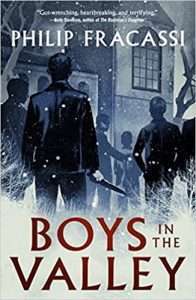 Like Fracassi’s previous novel, Gothic, Boys in the Valley involves devil-worship and demonic possession. The publisher’s pithy tagline describes Boys in the Valley as “The Exorcist meets Lord of the Flies, by way of Midnight Mass.” Similarities to The Exorcism are obvious, and both the absence of effective adult supervision and the pervasive child-on-child brutality certainly bring to mind Lord of the Flies. But despite being—at its heart—a religious horror novel, I would also recommend it to fans of John Carpenter’s The Thing (1982). Isolated and snow-bound, the orphanage may as well be as remote as an Antarctic research station, and its immediately clear that no outside help is forthcoming. Unlike many horror stories, where a singular devil flits from one host to the next in serial fashion, possession is treated here almost like an infection. Some demonic hosts are more insidiously subtle than others, engendering a heavy atmosphere of paranoia as alliances shift and former friends become lethal enemies.
Like Fracassi’s previous novel, Gothic, Boys in the Valley involves devil-worship and demonic possession. The publisher’s pithy tagline describes Boys in the Valley as “The Exorcist meets Lord of the Flies, by way of Midnight Mass.” Similarities to The Exorcism are obvious, and both the absence of effective adult supervision and the pervasive child-on-child brutality certainly bring to mind Lord of the Flies. But despite being—at its heart—a religious horror novel, I would also recommend it to fans of John Carpenter’s The Thing (1982). Isolated and snow-bound, the orphanage may as well be as remote as an Antarctic research station, and its immediately clear that no outside help is forthcoming. Unlike many horror stories, where a singular devil flits from one host to the next in serial fashion, possession is treated here almost like an infection. Some demonic hosts are more insidiously subtle than others, engendering a heavy atmosphere of paranoia as alliances shift and former friends become lethal enemies.
Despite the claustrophobic setting of Boys in the Valley, Fracassi effectively manages a large cast of characters. The various boys are all named and given evocative quirks. The lion’s share of characterization is given to the oldest two boys, the noble aspiring priest Peter and his cynical counterpart David, but through brief passages and conversations Fracassi manages to communicate each boy’s essential nature with surprising economy of words. With the end goal, of course, of making the reader really feel the blow whenever a particular boy meets a savage end at the hands of his fellows.
The pacing is another highlight of Boys in the Valley. Many authors would be tempted to prolong the first third of the novel, after the first boys start to change. Those authors would drip-feed the reader a series of unsettling events over several more chapters before the first murder takes place. Fracassi’s demons are impatient and ready to get to the carnage, however, with the whole sequence of events escalating very quickly. I appreciated the apparent confidence Fracassi had in the strength of his basic premise and his scene-setting ability. Rather than dragging things out unnecessarily, all hell breaks loose within the orphanage soon after Peter uncovers the demonic threat.
Previously published in 2001 as a 500 copy limited edition by Earthling Publications, Boys in the Valley is now being released by Tor Nightfire. Hopefully this mass market edition from a major publisher will introduce Fracassi to a wider audience of readers. After reading both Gothic and Boys in the Valley I am firmly convinced that Philip Fracassi is a name worthy of being included alongside other contemporary horror greats like Paul Tremblay, Nick Cutter, and Stephen Graham Jones. Boys in the Valley is a tense page-turner, absolutely gripping.
Read Boys in the Valley by Philip FracassiThe post REVIEW: Boys in the Valley by Philip Fracassi appeared first on Grimdark Magazine.
July 2, 2023
REVIEW: Gardens of the Moon by Steven Erikson
I first read Gardens of the Moon by Steven Erikson eight years ago. This was a few years before I started reviewing books and I was in a very different mental headspace to the one that I find myself in now. I do not look back on this period fondly. That being said, I read and loved this series throughout this stage. However difficult or messed up my life seemed, there was always a Malazan Book of the Fallen entry close by that helped me escape and assisted me with feeling things that I did not get from the real world. I have opted to re-read this series, to see how it holds up and, additionally, to see what I get from it now being the person that I am today.
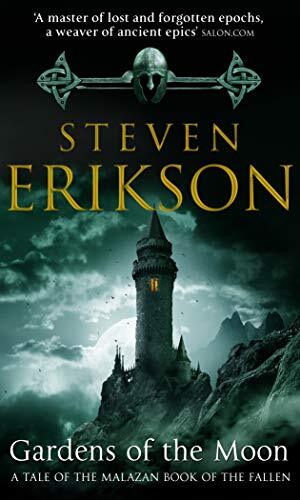 Gardens of the Moon is about Empress Laseen continually pushing for the expansion of the Malazan Empire. At her disposal, she has seasoned armies, powerful mages, Claw assassins, and many allies, both natural and unnatural. She is unforgiving, will backstab when required, and can go to what seem like absurdly risky lengths to get her way with domination. To commence, we join the action in Pale where the Malazan military are facing a confrontation from the impressive and very capable combined forces of Anomander Rake and his Tiste Andii, Pale’s army, warlord Caladan Brood, and The Crimson Guard.
Gardens of the Moon is about Empress Laseen continually pushing for the expansion of the Malazan Empire. At her disposal, she has seasoned armies, powerful mages, Claw assassins, and many allies, both natural and unnatural. She is unforgiving, will backstab when required, and can go to what seem like absurdly risky lengths to get her way with domination. To commence, we join the action in Pale where the Malazan military are facing a confrontation from the impressive and very capable combined forces of Anomander Rake and his Tiste Andii, Pale’s army, warlord Caladan Brood, and The Crimson Guard.
My memories from the first read are hazy, yet, back then I remember I did not quite feel the sense of being lost as many admit to when starting Gardens of the Moon. I will admit that I found it tough going at certain moments and I still believe the first page is a difficult read and that the glossary and dramatis personae are required. The beginning sets the standard that follows in that this series does not welcome you warmly with open arms. When you arrive as a reader, this world is living and breathing, has histories that span millennia and vast continents, presents existing power struggles between gods and immortals, warfare and factions and ranks and reputations, a broad array of races and contingents, and a complicated magic scheme where the rules are not explained. There are a large amount of point of view perspectives in Gardens of the Moon yet, we often find ourselves looking and learning through the eyes of the young noble Ganoes Paran, who is the closest to a main character Erikson presents in the book.
‘Every decision you make can change the world. The best life is the one the gods don’t notice. You want to live free, boy, live quietly.’
‘I want to be a soldier. A hero.’
‘You’ll grow out of it.’
Malazan Book of the Fallen features some of my favourite characters in fantasy literature. When reading Gardens of the Moon, I tried to forget what I knew and wished to analyse them based on the actions and dialogues of this novel alone. With that in mind, there are still so many intriguing and captivating members of the dramatis personae. Anomander Rake, Quick Ben, Sorry, Shadowthrone, Tattersail, Adjunct Lorn, Kalam, and Tool are just a few names out of thirty-plus that truly stand out. A vast amount of the major players are complicated and mysterious, with varied motives, multilayered personalities, and past experiences. For example, with Anomander Rake, is he a villain as he is fighting against the Malazan Empire? Is he as honourable as people mention? Is he a High Mage or something all the more impressive and frightening? When reading his mannerisms including when he chooses to laugh or speak sternly or with who he engages or the decisions he makes, this is a character so deep that you can almost feel the weight and burden that his long lifetime and his god-slaying sword, Draginpur, have laid on his shoulders.
The magic system in Malazan Book of the Fallen is phenomenal. Essentially, mages or wizards can access warrens. The warrens are magical realms, which can be traversed as a type of fast-travel, and are sources of power that those with the necessary attributes are able to draw from. Each warren has an element or flavour, such as Denul (healing) Meanas (shadow) and Kurald Galain (darkness) and, although they are rare, some powerful mages can access more than one warren simultaneously, making them extremely formidable. Sourcing from these magical domains comes at a cost and those who dabble unaware or without caution can go mad, die, or be consumed. In addition, the warrens can be the residing realms of various types of nastiness, such as things best left forgotten, wanderers, ascendents, gods, and hounds.
I fondly remembered that during my first read, I adored following the actions and drama that featured the Bridgeburners. They are a squad from the Malazan army who are respected and made up of a wide variety of talents including an ex-commander, an ex-Claw assassin, a Seven Cities Mage, a pair of sappers, a healer, and a possessed young girl. I also reflected that I was frustrated when, after finally feeling content that I had figured out what was happening, (following the Bridgeburners et al), the reader is whisked away to another city entirely with a whole new cast of characters to learn about. (There was an element of this on my re-read but I readjusted to the new setting and players promptly.) In Darujhistan, there are a few great character creations to follow also, but this side of the story did not gel with me as strongly. In this city, there is a war of assassins and a variety of class and political infighting and intrigue. This section is a slower burn than the sieges and magical battles elsewhere, yet does pay off by the finale which features half a dozen standout segments, showdowns, twists, and deaths.
Having read the book twice now, I assess that Erikson has done admirably with the pacing of Gardens of the Moon. However, the first time I read this, my reading pace would not have been smooth at the beginning, as I was trying to get my head around the novel’s many elements. On my re-read, it seemed easier and by the time I reached Book 4 Assassins, I was racing through the pages, culminating with me devouring over 150 pages in a couple of hours this morning. The ending is well-worked and has three or four moments that could be the finale before the novel finds another gear or twist, concluding in an exhilarating fashion. A huge plus is that I find the unpredictability of Gardens of the Moon and later series entries fascinating. Before the novel closes, it neatly sets up the journies and endeavours that are to follow for the cast in Deadhouse Gates and Memories of Ice.
For the most part, the writing in Gardens of the Moon is well-crafted and paints an excellent introductory view of the vastness and complicatedness of the Malazan Universe. Some moments may be over-descriptive and during my re-read, I noticed parts that would make extremely little sense to a fresh-eyed, first-time series reader. The dialogue presented in Gardens of the Moon is strong, and one of my favourite scenes is a fairly emotional farewell between a wizard and a demon. Knowing what follows, I can see that some elements of the humour, camaraderie, and philosophical musings present in Gardens of the Moon had not yet been perfectly honed by Erikson. Even with that considered, the potential and statement made by the author presenting this as a debut, looking back, is immensely impressive.
‘Don’t quibble with words,’ Dujek muttered. ‘Damn it, Fiddler, is that your sword lying over there? In a puddle?’
Breath hissed between Fiddler’s teeth and he hurried over to the weapon.
‘The man’s a hopeless legend,’ Dujek said.
An element of my re-read that I hugely enjoyed was the foreshadowing and seeing how aware Erikson was, even at this early stage of this series, where this story would lead. For example, he mentions, quite early on, the Tiste Edur, a race that does not feature until the fifth novel Midnight Tides. This is absolutely a story that is worth paying close attention to. A seer mentions something in the first few chapters that could sound, to a casual reader, like nonsense, yet is of great importance to a standout scene later on. I definitely caught more of these special nuggets understanding the world’s jargon and history more on my second visit to this narrative.
I am wholeheartedly delighted that I decided to re-read Gardens of the Moon, which seems like an oxymoron when considering that this is often a brutal and unforgiving dark fantasy epic. My next steps are to review the rest of the novels in this series including Ian C. Esslemont’s books Novels of the Malazan Empire when they fit chronologically.
If you have not yet read Malazan Book of the Fallen, I would recommend it highly. I also strongly encourage being diligent when researching it online as this is a series that is best to appreciate and be amazed by unspoiled. 8.5/10.
Read Gardens of the Moon by Steven EriksonToo many regrets. Lost chances – and with each one passing the less human we all became, and the deeper into the nightmare of power we all sank.
The post REVIEW: Gardens of the Moon by Steven Erikson appeared first on Grimdark Magazine.
Grimdark Magazine #35 is here!
Some of my favorite books are terrifying. I started reading Stephen King at a way-too-early age, and it has indelibly affected how I like my stories: dark, gruesome, and grim. This month we set out to celebrate horror as a genre and feature stories that toe the line between grimdark and horror. These two genres often walk hand and hand, but instead of the good guys always winning, we have the stories of the morally gray.
As a child, horror novels became worn-out objects from the hours sitting under the covers with a flashlight. I watched Carrie be doused in pig’s blood and lose her mind on her schoolmates, It instilled a fear of clowns, and Annie Wilkes taught me that sometimes horrors of the mind and the evil done by men are much scarier than a ghost or any vampire. Still, to this day, Annie Wilkes remains one of the most frightening characters I have ever read. There is something primal in fear, and reading it from the safe confines of a comfy chair while drinking tea allows us to stick our toes into the terrifying dark without being grabbed and hauled in.
Caitlin Starling, Eric LaRocca, Aliette de Bodard, Josh Rountree, and Gemma Amor have written stories that push the boundaries of fear and the uncomfortable. But we made sure to have stories that will satiate the grisliest grimdark lover. Take a trip with us into the terrifying worlds created by these talented storytellers.
Enjoy, and remember this adage, “Holy men tell us life is a mystery. They embrace that concept happily. But some mysteries bite and bark and come to get you in the dark.” Cheers, and happy reading.
GdM#35 coverCarlos Diaz has brought Caver, Continue by Caitlin Starling to life with this quarter’s cover art. The horror and the claustrophobia really hits for me, here, and I hope it gets you in the right mood for Grimdark Magazine Issue #35!
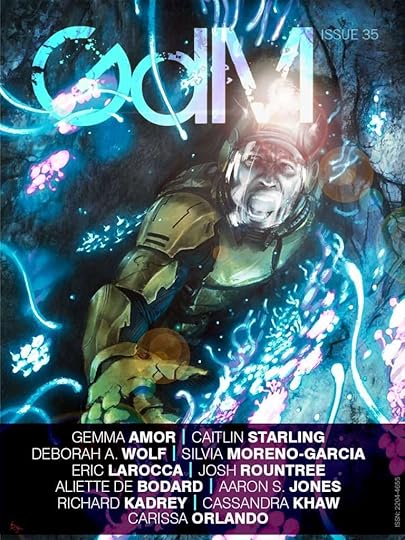
Grimdark Magazine presents the darker, grittier side of fantasy and science fiction. Each quarterly issue features established and new authors to take you through their hard-bitten worlds alongside articles, reviews and interviews. Our stories are grim, our worlds are dark and our morally grey protagonists and anti-heroes light the way with bloody stories of war, betrayal and action.
FICTIONCaver, Continue by Caitlin StarlingWe Have Always been This Way by Eric LaRoccaLullaby for A Lost World by Aliette de BodardLast Pale Light in the West by Josh RountreeNo Secrets Here by Gemma AmorNON-FICTIONAn Interview with Silvia Moreno-GarciaReview: The Dead Take the A Train by Cassandra Khaw and Richard KadreAn Interview with Richard KadreyReview: The Militia House by John MilasThe Comfort in Horror by Aaron S. JonesReview: The Vampires of El Norte by Isabel CañasAn Interview with Carissa OrlandoWeird Horror by Deborah WolfRead GdM#35Other formats available in the Grimdark Magazine webstore.
The post Grimdark Magazine #35 is here! appeared first on Grimdark Magazine.

